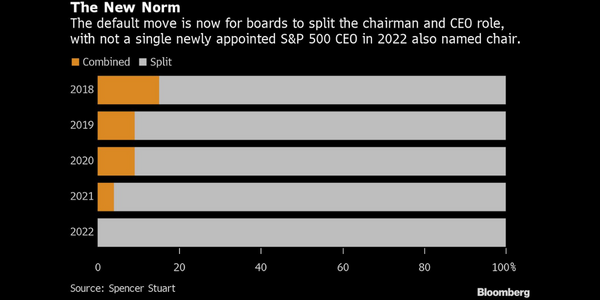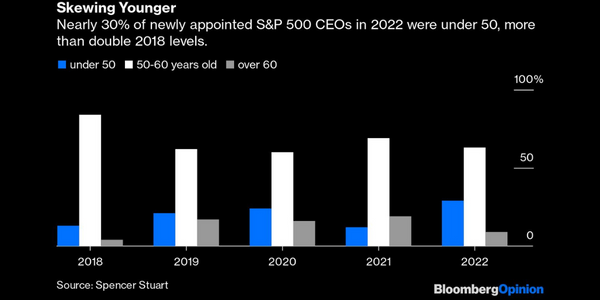Geneva-bound director sings CDC praises
Marc Rivers shares how he found the Institute of Directors Company Directors’ Course a valuable experience.

(Bloomberg Opinion) -- The pandemic aged all of us, but it especially aged the American CEO, writes Beth Kowitt.
Corporate boards, looking for continuity during a global health crisis, stuck with their top leadership rather than bring in someone new. Giants like Boeing Co., Target Corp. and Caterpillar Inc. all either raised, eradicated or waived their mandatory retirement ages so their CEOs could stay in the seat longer.
When companies did make a CEO transition, older candidates got tapped for the job. The age of newly appointed CEOs, already creeping up for the past five years, peaked in 2021 at 56 with as many as one in six over 60, according to a new report from executive search firm Spencer Stuart. The presiding logic: Older equals more experienced and better equipped for navigating through the turbulence.
It makes sense then that last year, as chief executive turnover started to normalise after the pandemic slowdown, that retiring CEOs were older and clocked in with longer tenures after having delayed their departures — 62.6 years old with 10.2 years in the job, according to Spencer Stuart. Between 2011 and 2020, the average tenure of an outgoing CEO had never surpassed a decade-long run.

But something big shifted in CEO succession in 2022. While outgoing CEOs were older, suddenly incoming CEOs started to skew younger. Spencer Stuart found that the average age of newly appointed chief executives fell to just under 54. While that might not seem like a huge drop on the surface, it was the largest year-over-year decline for S&P 500 companies since 2000, with nearly 30% of the new cohort under 50. In 2021, only 12% of those jobs went to executives under 50.
I won’t argue one way or another about whether the dip in average age indicates that boards, as we ease back to some semblance of normalcy, are now valuing the fresh thinking that can come with relative youth over the merits of experience that accompany age. What’s far more significant is that the real decision makers in corporate America are signaling that they’re finally ready for the CEOs of the future to look different from the CEOs of the past — read: younger, less white and less male.
The youngest S&P 500 CEO appointed last year also happened to be a woman — Sarah London, 42, of health insurer Centene Corp. London is among the 13% of all new CEOs in 2022 who were female, up from 6% in 2021, according to Spencer Stuart. (The search firm does not track CEO transitions by race or ethnicity.) That doubling in women CEOs is off a depressingly low base: seven out of 56 in 2022 from three of 48 the prior year, so don’t get too excited. But there are other signs that number could tick up in the not-too-distant future. As companies sought leaders who can manage through a chaotic economic environment, Spencer Stuart reported a spike in CFO-to-CEO handoffs in 2022, comprising 16% of transitions and up from just 4% in 2020. The surge came the same year that the percentage of female CFOs hit an all-time high. If both of those trends continue, there’s a good chance we’ll see more women ascend to the top job.

We also have real evidence of what can happen when directors look beyond the standard resume and sets of experiences, which is now the approach they’re taking with their own boardroom peers. Historically it seemed that the single biggest precursor for being named a director was prior director experience. It doesn’t take a big leap to see how these kinds of parameters turned corporate boards into an old boys’ network. But last year, a separate Spencer Stuart study found that in 2021 and 2022, more than one-third of all new S&P board members had never served as directors before. And guess what? That led to a dramatically more diverse slate: 72% of all new directors were from underrepresented groups in both of those years.
There are structural changes at play, too, that have made it easier for boards to opt for what they might consider a less-tested candidate whose experience doesn’t check every single box. Last year, for the first time, in not one of the 56 transitions did a CEO also become the board chair. It’s hard to overstate what a massive shift this is for corporate America. Even five years ago, 15% of new CEOs were also named chairman. Splitting the CEO and chairman role is good governance, but it’s also what James Citrin, head of Spencer Stuart’s CEO Practice, says is an acknowledgement that leadership is a team sport. “No one can do it alone,” he told me.
There’s a risk now as we face off against a period of economic uncertainty that boards will fall back on their old habits, relying on outdated paradigms of who should and shouldn’t be a CEO. That might be the comfortable choice, but it’s a mistaken one. Companies are facing new kinds of challenges and expectations today than they have in the past. Maybe it’s time for a new kind of leader to tackle them.
More stories like this are available on bloomberg.com
©2022 Bloomberg L.P.
The views expressed in this article do not reflect the position of the IoD unless explicitly stated.